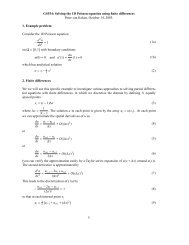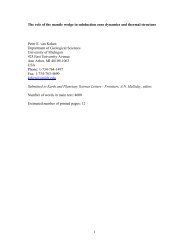Quantitative paleoenvironmental and paleoclimatic reconstruction ...
Quantitative paleoenvironmental and paleoclimatic reconstruction ...
Quantitative paleoenvironmental and paleoclimatic reconstruction ...
You also want an ePaper? Increase the reach of your titles
YUMPU automatically turns print PDFs into web optimized ePapers that Google loves.
ARTICLE IN PRESS<br />
N.D. Sheldon, N.J. Tabor / Earth-Science Reviews xxx (2009) xxx–xxx<br />
21<br />
levels, new CO 2 “minerals” were created for 0.1, 1, 3, 5, 10, 15, <strong>and</strong> 20<br />
times present atmospheric levels (PAL) assuming a present day<br />
atmospheric pCO 2 of 10 − 3.5 (for dilute mixtures, e.g., CO 2 in the<br />
atmosphere, f≈p). All equilibrium K values are from the SOLTHERM<br />
database (construction of the database is outlined in Pal<strong>and</strong>ri <strong>and</strong><br />
Reed, 2001). The basic equation that controls the availability of CO 2 is:<br />
H 2 O ðaq ÞþCO 2 ðgÞ ¼HCO − 3 ðaqÞþH þ ðaqÞ:<br />
ð37Þ<br />
From here, a K value may be calculated from the following (where<br />
a represents activity):<br />
a H +<br />
K = a HCO − 3<br />
f CO2 a H2 O<br />
ð38Þ<br />
Rearranging that expression (Eq. (39)) <strong>and</strong> taking the Log 10 of both<br />
sides (Eq. (40)) permits calculation of a new K value (here called K⁎) that<br />
can be used to force equilibrium with a given atmospheric CO 2 value.<br />
<br />
f CO2 K = a HCO − 3<br />
a H2 O<br />
a H +<br />
<br />
Log K4 =Log f CO2 +LogK =Log a HCO − 3<br />
a H2 O<br />
a H +<br />
ð39Þ<br />
ð40Þ<br />
For example, to create a new CO 2 gas “mineral” that corresponds to<br />
present-day atmospheric conditions (i.e., pCO 2 =10 − 3.5 bars), the<br />
following expression would be used:<br />
Log K4 = 10 − 7:818 +10 − 3:5<br />
ð41Þ<br />
For the modeling, O 2 fugacity/pressure was kept constant at present<br />
levels, which is reasonable because oxygen levels are thought to have<br />
been roughly constant throughout the Cenozoic. CHILLER may be used<br />
to examine different water-rock ratios by “titrating” rock into a water of a<br />
given composition (i.e., rainwater) <strong>and</strong> by outputting how that water<br />
changes composition in response to the addition of rock. If precipitation<br />
is approximately constant through time, then there should be a<br />
systematic decrease in the amount of water that reacted with the<br />
parental basalt with increasing depth in the profile (Sheldon, 2006d).<br />
Thus, by graphing results depicting ascending water-rock ratios from the<br />
top down, an artificial soil profile may be modeled (Sheldon, 2006d).<br />
These artificial profiles obtained for equilibriumwith different CO 2 levels<br />
(0.1–20 PAL) can then be compared with actual geochemical data on<br />
mass balance <strong>and</strong> the mineral assemblage from Sheldon (2003).<br />
The rainwater composition used in the modeling may be found in<br />
Sheldon (2006d). Because rainwater is very fresh (i.e., has low salinity<br />
<strong>and</strong> low total-dissolved solids), most of the cations available for<br />
reactions come from the rock(s) being weathered. Pedogenesis is<br />
dominated by the breakdown of base-bearing minerals either by<br />
hydrolysis (e.g., potassium feldspar being weathered to illite) or by<br />
acid attack that liberates cations for use by plants <strong>and</strong> microbes. An<br />
example of the latter type of reaction would be the dissolution of the<br />
plagioclase feldspars albite or anorthite:<br />
NaAlSi 3 O 8 albite þ 4H þ ¼ Na þ þ Al 3þ þ 3SiO 2ðaqÞ þ 2H 2 O<br />
CaAl 2 Si 2 O 8 anorthite þ 8H þ ¼ Ca 2þ þ 2Al 3þ þ 2SiO 2ðaqÞ þ 4H 2 O<br />
ð42Þ<br />
ð43Þ<br />
where the resulting species are all aqueous. Acid attack reactions<br />
consume H + ions, thereby raising the pH of the system, <strong>and</strong> providing<br />
a long-term control on atmospheric pCO 2 (e.g., Berner, 2004). While<br />
HCO 3 − is the most stable carbon-bearing species at near neutral pH<br />
values (5.5–8), CO 3 2− becomes the most stable species at higher pH<br />
values (N8). This change leads to the precipitation of carbonate minerals<br />
such as calcite, siderite, <strong>and</strong> ankerite. However, all of the<br />
interflow paleosols of the Picture Gorge Subgroup are carbonate-free,<br />
so the first appearance of carbonate minerals can be taken to represent<br />
the end point of the realistic weathering reaction (Sheldon,<br />
2006b).<br />
Atmospheric pCO 2 values of 0.1, 1, 3, 5, 10, 15, <strong>and</strong> 20 PAL were used<br />
in model calculations, where 0.1 PAL is an extreme case used to<br />
represent the sub-modern pCO 2 levels suggested by Pagani et al.<br />
(1999) <strong>and</strong> Royer et al. (2001a,b). All model calculations were for<br />
25 °C temperature conditions, which is within 10 °C of paleotemperature<br />
estimates from the paleosols themselves (Sheldon, 2003,<br />
2006d) <strong>and</strong> paleobotanical estimates (Graham, 1999). Using a reaction<br />
temperature of 25 °C has the additional advantage of being the<br />
temperature at which most thermodynamic data are best-constrained.<br />
All model calculations were run over the range of 0.001–<br />
10 g of rock added to a kilogram of water, or 10 − 3 to 10 1 g of rock<br />
titrated. In all cases, calcite precipitated before the end of the titration<br />
run. Taking into account both kinetic factors <strong>and</strong> the temperature, a<br />
number of zeolite <strong>and</strong> high-temperature minerals were suppressed<br />
from forming in the calculations.<br />
A thorough description of the model results (including mineralogical<br />
data) may be found in Sheldon (2006d), but to illustrate<br />
what the model outputs look like <strong>and</strong> how they are comparable to<br />
other tools for assessing pedogenesis, Fig. 13 compares model results<br />
for Ca 2+ <strong>and</strong> Na + in the soil water solution with mass balance results<br />
(see Section 5.3 for the method) obtained from the type section of<br />
middle Miocene Ilukas pedotype, which is found throughout the<br />
Picture Gorge Subgroup (Sheldon, 2006d). Weathering is typically<br />
most intense near the surface of a soil <strong>and</strong> declines rapidly with<br />
increasing depth <strong>and</strong> decreasing permeability (both initial <strong>and</strong> as a<br />
direct result of plant-rock interactions). Therefore, with the titration<br />
of progressively more rock into solution we would expect an increase<br />
in the activity (<strong>and</strong> by extension, molality) of a given cation. This<br />
pattern is observed in the model calculations for Na + <strong>and</strong> Ca 2+<br />
(though the same result was found for other common base cations;<br />
Sheldon, 2006d). In addition, to reproducing the expected cation<br />
distributions indicated by mass-balance calculations, the model also<br />
produced reasonable pH values for Alfisol-like (Argillisols) paleosols,<br />
<strong>and</strong> produced reasonable water-rock ratios during pedogenesis<br />
relative to a calculated “real” water-rock ratio based on estimates of<br />
MAP (Sheldon, 2006d).<br />
The 10 PAL model run was also favored as the most likely scenario<br />
because only the 10 PAL case produced a significant amount of Mg 2+ .<br />
That value represents an upper limit to pCO 2 though, because higher<br />
pCO 2 values result in dolomite precipitation <strong>and</strong> dolomite is not<br />
observed in the paleosols <strong>and</strong> is unlikely to form in any soils for kinetic<br />
reasons (Capo et al., 2000). That the 10 PAL case best matches the<br />
geologic evidence raises the question of how much of that total pCO 2<br />
is due to atmospheric pCO 2 <strong>and</strong> how much is due to soil productivity.<br />
Using the world soil pCO 2 map of Brook et al. (1983), modern soils like<br />
the Picture Gorge Subgroup paleosols have 3–8 PAL soil pCO 2 . If one<br />
assumes that 10 PAL is the total soil pCO 2 , from both atmospheric <strong>and</strong><br />
soil respiration sources necessary to produce the Picture Gorge<br />
Subgroup paleosols, then atmospheric pCO 2 likely ranged from 2 to<br />
7 PAL for the transient middle Miocene climatic optimum (Sheldon,<br />
2006d). Even at the low end of that range, it is likely that sub-pre-<br />
Industrial atmospheric pCO 2 levels, as suggested by Pagani et al.<br />
(1999), are too low. Furthermore, a value of 2–4 PAL is consistent with<br />
estimates from stomatal index (Retallack 2002; Kürschner et al.,<br />
2008) <strong>and</strong> mass-balance modelling (Berner <strong>and</strong> Kothavala 2001;<br />
though cf. Berner, 2005). The model results do not preclude the<br />
possibility of very low atmospheric pCO 2 coupled with non-analogous<br />
biotic productivity in the Ilukas paleosols (i.e., unusually high productivity<br />
forests). However, that scenario is unlikely because the flora<br />
<strong>and</strong> fauna of the middle Miocene was not substantially different from<br />
a modern one (e.g., Janis et al., 2002), so it is more likely that modernanalogue<br />
forests have comparable productivity to their Miocene<br />
Please cite this article as: Sheldon, N.D., Tabor, N.J., <strong>Quantitative</strong> <strong>paleoenvironmental</strong> <strong>and</strong> <strong>paleoclimatic</strong> <strong>reconstruction</strong> using paleosols, Earth-<br />
Science Reviews (2009), doi:10.1016/j.earscirev.2009.03.004















